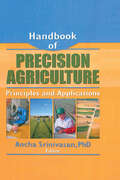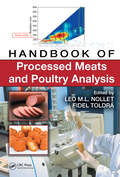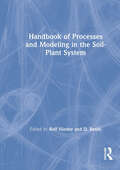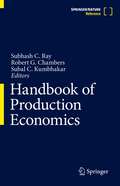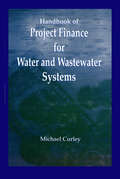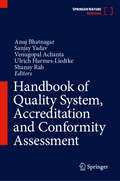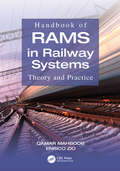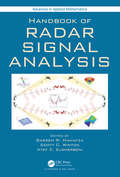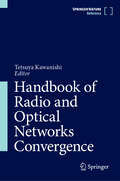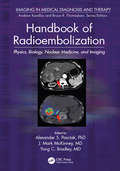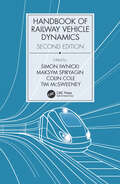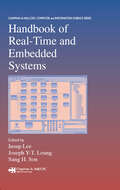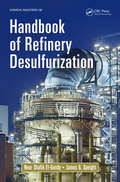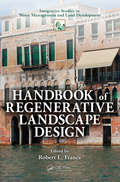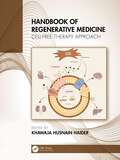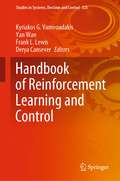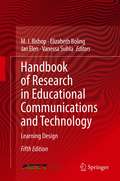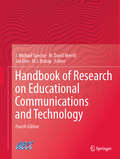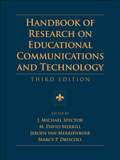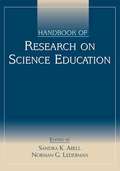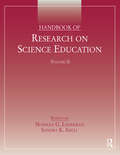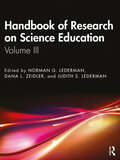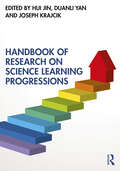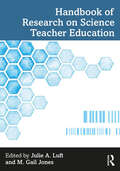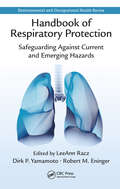- Table View
- List View
Handbook of Precision Agriculture: Principles and Applications
by Ancha SrinivasanA thorough, critical, and up-to-date look at precision farming around the worldIn most developing countries, farming is the best safety net against hunger and keeping production costs under control without sacrificing crop yield is essential for survival. The Handbook of Precision Agriculture presents up-to-date research, field studies,
Handbook of Processed Meats and Poultry Analysis
by Fidel Toldrá Leo M.L. NolletMuscle foods include a wide range of processed meats and poultry, and therefore represent an important percentage of total worldwide food consumption. The sheer volume of products and the variety of processes available makes analyzing them problematic. Co-Edited by Fidel Toldra - Recipient of the 2010 Distinguished Research Award from the American
Handbook of Processes and Modeling in the Soil-Plant System
by Rolf Nieder Dinesh K. BenbiLearn to create and use simulation modelsthe most reliable and cost-effective tools for predicting real-world results! The Handbook of Processes and Modeling in the Soil-Plant System is the first book to present a holistic view of the processes within the soil-plant-atmosphere continuum. Unlike other publications, which tend to be more specialized, this book covers nearly all of the processes in the soil-plant system, including the fundamental processes of soil formation, degradation, and the dynamics of water and matter. It also illustrates how simulation modeling can be used to understand and forecast multiple interactions among various processes and predict their environmental impact. This unique volume assembles information that until now was scattered among journals, bulletins, reports, and symposia proceedings to present models that simulate almost all of the processes occurring in the soil-plant system and explores the results that these models are capable of producing. With chapters authored by experts with years of research and teaching experience, the Handbook of Processes and Modeling in the Soil-Plant System examines: physical, chemical, and biological soil processes the soil formation and weathering process and its modeling the impact of radioactive fallout on the soil-plant system soil degradation processes and ways to control them water and matter dynamics in the soil-plant system growth and development of crops at various levels of production the potentials and limitations of using simulation models Students, educators, and professionals alike will find the Handbook of Processes and Modeling in the Soil-Plant System an invaluable reference on the soil-plant-atmosphere system and an ideal tool to help develop an effective decision support system.
Handbook of Production Economics
by Subal C. Kumbhakar Subhash C. Ray Robert G. ChambersThis three-volume handbook includes state-of-the-art surveys in different areas of neoclassical production economics. Volumes 1 and 2 cover theoretical and methodological issues only. Volume 3 includes surveys of empirical applications in different areas like manufacturing, agriculture, banking, energy and environment, and so forth.
Handbook of Project Finance for Water and Wastewater Systems
by Michael CurleyHandbook of Project Finance for Water and Wastewater Systems provides an easy-to-read guide for gaining an understanding of the myriad options available for financing water and wastewater projects and how to evaluate which options are most appropriate. This crucial reference delineates a basic system for comparing the actual costs of variou
Handbook of Quality System, Accreditation and Conformity Assessment
by Sanjay Yadav Shanay Rab Anuj Bhatnagar Venugopal Achanta Ulrich Harmes-LiedtkeThis handbook comprehensively covers the topics of quality system, accreditation and conformity assessment. The main sections in this handbook covers topics such as conformity assessment, accreditation and certification, measurement requirements and conformity assessment, management systems, Product quality and safety and future of conformity assessment. This multidisciplinary handbook will be a useful reference for researchers and professionals across disciplines who are involved in conformity assessment activities.
Handbook of RAMS in Railway Systems: Theory and Practice
by Enrico Zio Qamar MahboobThe Handbook of RAMS in Railway Systems: Theory and Practice addresses the complexity in today's railway systems, which use computers and electromechanical components to increase efficiency while ensuring a high level of safety. RAM (Reliability, Availability, Maintainability) addresses the specifications and standards that manufacturers and operators have to meet. Modeling, implementation, and assessment of RAM and safety requires the integration of railway engineering systems; mathematical and statistical methods; standards compliance; and financial/economic factors. This Handbook brings together a group of experts to present RAM and safety in a modern, comprehensive manner.
Handbook of Radar Signal Analysis (Advances in Applied Mathematics)
by Bassem R. MahafzaThis new handbook on radar signal analysis adopts a deliberate and systematic approach. It uses a clear and consistent level of delivery while maintaining strong and easy-to-follow mathematical details. The emphasis of this book is on radar signal types and their relevant signal processing and not on radar systems hardware or components. This handbook serves as a valuable reference to a wide range of audience. More specifically, college-level students, practicing radar engineers, as well as casual readers of the subject are the intended target audience of the first few chapters of this book. As the book chapters progress, these grow in complexity and specificity. Accordingly, later chapters are intended for practicing engineers, graduate college students, and advanced readers. Finally, the last few chapters contain several special topics on radar systems that are both educational and scientifically entertaining to all readers. The presentation of topics in this handbook takes the reader on a scientific journey whose major landmarks comprise the different radar subsystems and components. In this context, the chapters follow the radar signal along this journey from its birth to the end of its life. Along the way, the different relevant radar subsystems are analyzed and discussed in great detail. The chapter contributors of this new handbook comprise experienced academia members and practicing radar engineers. Their combined years of academic and real-world experiences are in excess of 175. Together, they bring a unique, easy-to-follow mix of mathematical and practical presentations of the topics discussed in this book. See the "Chapter Contributors" section to learn more about these individuals.
Handbook of Radio and Optical Networks Convergence
by Tetsuya KawanishiThis handbook provides comprehensive knowledge on device and system technologies for seamlessly integrated networks of various types of transmission media such as optical fibers and millimeter and THz waves to offer super high-speed data link service everywhere. The seamless integration of the knowledge of radio and optical technologies is needed to construct wired and wireless seamless networks. High-frequency bands such as millimeter-wave and THz-wave bands where super wideband spectra are available can offer high-speed data transmission and high-resolution sensing. However, the expected coverage is limited due to large wave propagation loss. Thus, convergence of radio and optical links is indispensable to construct worldwide networks. The radio and optical technologies share the same physics and are closely related to each other but have been developed independently. Therefore, there is a big gap between these two fields. Bridging the two fields, this handbook is also intended as a common platform to design integrated networks consisting of wireless and wired links. Full coverage of wireless and wired convergence fields ranging from basics of device and transmission media to applications allows the reader to efficiently access all the important references in this single handbook. Further, it also showcases state-of-the-art technology and cases of its use.
Handbook of Radioembolization: Physics, Biology, Nuclear Medicine, and Imaging (Imaging in Medical Diagnosis and Therapy)
by Alexander S. Pasciak, J. Mark McKinney and Yong C. BradleyRadioembolization is a widely used treatment for non-resectable primary and secondary liver cancer. This handbook addresses the radiation biology, physics, nuclear medicine, and imaging for radioembolization using Yttrium-90 (90Y) microspheres, in addition to discussing aspects related to interventional radiology. The contents reflect on and off-label treatment indications, dose-response relationships, treatment-planning, therapy optimization, radiation safety, imaging follow-up and many other facets of this therapy necessary for both novice and advanced users alike.
Handbook of Railway Vehicle Dynamics, Second Edition
by Maksym Spiryagin Colin Cole Tim McSweeney Simon IwnickiHandbook of Railway Vehicle Dynamics, Second Edition, provides expanded, fully updated coverage of railway vehicle dynamics. With chapters by international experts, this work surveys the main areas of rolling stock and locomotive dynamics. Through mathematical analysis and numerous practical examples, it builds a deep understanding of the wheel-rail interface, suspension and suspension component design, simulation and testing of electrical and mechanical systems, and interaction with the surrounding infrastructure, and noise and vibration. Topics added in the Second Edition include magnetic levitation, rail vehicle aerodynamics, and advances in traction and braking for full trains and individual vehicles.
Handbook of Real-Time and Embedded Systems (Chapman & Hall/CRC Computer and Information Science Series)
by Insup Lee Joseph Y-T. Leung Sang H. SonReal-time and embedded systems are essential to our lives, from controlling car engines and regulating traffic lights to monitoring plane takeoffs and landings to providing up-to-the-minute stock quotes. Bringing together researchers from both academia and industry, the Handbook of Real-Time and Embedded Systems provides comprehensive covera
Handbook of Refinery Desulfurization (Chemical Industries)
by James G. Speight Nour Shafik El-GendyHandbook of Refinery Desulfurization describes the operation of the various desulfurization process units in a petroleum refinery. It also explains the processes that produce raw materials for the petrochemical industry. It illustrates all the possible processes to lower the sulfur contents in petroleum and its fractions to decrease emissions of su
Handbook of Regenerative Landscape Design
by Robert L. FranceWhat if environmentally damaged landscapes could not only be remediated from an ecological standpoint, but also designed to replenish an entire community as well as the nature surrounding it? The Handbook of Regenerative Landscape Design incorporates ecology, engineering, sociology, and design elements into a new paradigm for environmental r
Handbook of Regenerative Medicine: Cell-Free Therapy Approach
by Khawaja Husnain HaiderThis book comprehensively reviews cell-free therapy approaches, focusing on the therapeutic potential of mesenchymal stem cell-derived extracellular vesicles (EVs) and secretomes across various reparative and regenerative medicine fields. The initial chapters primarily provide foundational insights into the application of EVs in dentistry, cardiovascular pathologies, and kidney injury. Each chapter discusses the role of mesenchymal stem cell exosomes in targeted therapies for conditions like neurodegenerative disorders, ophthalmological diseases, and diabetes complications, examining the applications of EV-based techniques in personalized medical strategies. The subsequent chapters discuss the advanced diagnostic and therapeutic applications, including using EVs as biomarkers in liquid biopsies and novel tissue engineering and cell-free scaffolding techniques for organ rejuvenation and tissue regeneration. Additionally, this book examines the challenges and progress in transitioning these therapies from laboratory research to clinical applications, covering critical aspects of formulation, Good Manufacturing Practice (GMP) production, regulatory approval, and market access. With insights into emerging technologies like 3D cell scaffolding and theragnostic applications in cancer and neurodegenerative diseases, this book emphasizes the future of a cell-free approach in regenerative medicine. This book is a useful resource for researchers and students in regenerative medicine.Key Features: Provides insights into EV-based therapies and their role in regenerative medicine across multiple medical fields Discusses the potential of mesenchymal stem cell-derived exosomes in treating neurodegenerative, ophthalmological, and cardiovascular conditions Explores cell-free scaffolding for targeted tissue and organ regeneration Reviews the current regulatory, production, and clinical challenges in bringing cell-free therapies to market Explores cutting-edge theragnostic applications of EVs in oncology and neurological disorders
Handbook of Reinforcement Learning and Control (Studies in Systems, Decision and Control #325)
by Frank L. Lewis Kyriakos G. Vamvoudakis Yan Wan Derya CanseverThis handbook presents state-of-the-art research in reinforcement learning, focusing on its applications in the control and game theory of dynamic systems and future directions for related research and technology.The contributions gathered in this book deal with challenges faced when using learning and adaptation methods to solve academic and industrial problems, such as optimization in dynamic environments with single and multiple agents, convergence and performance analysis, and online implementation. They explore means by which these difficulties can be solved, and cover a wide range of related topics including:deep learning;artificial intelligence;applications of game theory;mixed modality learning; andmulti-agent reinforcement learning.Practicing engineers and scholars in the field of machine learning, game theory, and autonomous control will find the Handbook of Reinforcement Learning and Control to be thought-provoking, instructive and informative.
Handbook of Research in Educational Communications and Technology: Learning Design
by Jan Elen M. J. Bishop Elizabeth Boling Vanessa SvihlaThe 5th edition of the prestigious AECT Handbook continues previous efforts to reach outside the traditional instructional design and technology community to the learning sciences and computer information systems communities toward developing a conceptualization of the field. However, given the pervasive and increasingly complex role technology now plays in education since the 1st edition of the Handbook in 1996, the editors have reorganized the research chapters in this edition to focus on the learning problems we are trying to solve with educational technologies, rather than to focus on the things we are using to solve those problems. Additionally, for the first time this edition of the Handbook reflects our field’s growing understanding of the importance of design scholarship to inform practice by including design case chapters. These changes for this edition of the Handbook are intended to bring educational technology research into the broader framework of educational research by elaborating on the role instructional design and technology plays as a scholarly discipline in addressing education’s increasingly complex issues.Provides comprehensive reviews of new developments in educational technology research and design practice.Includes concrete examples to guide future research and practice in the ways emerging technologies can be used to solve educational problems.Contains extensive references furnished to guide readers to the most recent research and design practice in the field of instructional design and technology.
Handbook of Research on Educational Communications and Technology
by J. Michael Spector M. David Merrill Jan Elen M. J. BishopThe 4th edition of the Handbook of Research on Educational Communications and Technology expands upon the previous 3 versions, providing a comprehensive update on research pertaining to new and emerging educational technologies. Chapters that are no longer pertinent have been eliminated in this edition, with most chapters being completely rewritten, expanded, and updated Additionally, new chapters pertaining to research methodologies in educational technology have been added due to expressed reader interest. Each chapter now contains an extensive literature review, documenting and explaining the most recent, outstanding research, including major findings and methodologies employed. The Handbook authors continue to be international leaders in their respective fields; the list is cross disciplinary by design and great effort was taken to invite authors outside of the traditional instructional design and technology community.
Handbook of Research on Educational Communications and Technology: A Project of the Association for Educational Communications and Technology (AECT Series #2)
by J. Michael Spector M. David Merrill Marcy P. Driscoll Jeroen Van MerriËNboerFirst Published in 2008. Routledge is an imprint of Taylor & Francis, an informa company.
Handbook of Research on Science Education
by Norman G. Lederman Sandra K. AbellThis state-of-the art research Handbook provides a comprehensive, coherent, current synthesis of the empirical and theoretical research concerning teaching and learning in science and lays down a foundation upon which future research can be built. The contributors, all leading experts in their research areas, represent the international and gender diversity that exists in the science education research community. As a whole, the Handbook of Research on Science Education demonstrates that science education is alive and well and illustrates its vitality. It is an essential resource for the entire science education community, including veteran and emerging researchers, university faculty, graduate students, practitioners in the schools, and science education professionals outside of universities. The National Association for Research in Science Teaching (NARST) endorses the Handbook of Research on Science Education as an important and valuable synthesis of the current knowledge in the field of science education by leading individuals in the field. For more information on NARST, please visit: http://www.narst.org/.
Handbook of Research on Science Education, Volume II
by Norman G. Lederman Sandra K. AbellBuilding on the foundation set in Volume I—a landmark synthesis of research in the field—Volume II is a comprehensive, state-of-the-art new volume highlighting new and emerging research perspectives. The contributors, all experts in their research areas, represent the international and gender diversity in the science education research community. The volume is organized around six themes: theory and methods of science education research; science learning; culture, gender, and society and science learning; science teaching; curriculum and assessment in science; science teacher education. Each chapter presents an integrative review of the research on the topic it addresses—pulling together the existing research, working to understand the historical trends and patterns in that body of scholarship, describing how the issue is conceptualized within the literature, how methods and theories have shaped the outcomes of the research, and where the strengths, weaknesses, and gaps are in the literature. Providing guidance to science education faculty and graduate students and leading to new insights and directions for future research, the Handbook of Research on Science Education, Volume II is an essential resource for the entire science education community.
Handbook of Research on Science Education: Volume III
by Judith S. Lederman Norman G. Lederman Dana L. ZeidlerVolume III of this landmark synthesis of research offers a comprehensive, state-of-the-art survey highlighting new and emerging research perspectives in science education. Building on the foundations set in Volumes I and II, Volume III provides a globally minded, up-to-the-minute survey of the science education research community and represents the diversity of the field. Each chapter has been updated with new research and new content, and Volume III has been further developed to include new and expanded coverage on astronomy and space education, epistemic practices related to socioscientific issues,design-based research, interdisciplinary and STEM education, inclusive science education, and the global impact of nature of science and scientific inquiry literacy. As with the previous volumes, Volume III is organized around six themes: theory and methods of science education research; science learning; diversity and equity; science teaching; curriculum and assessment; and science teacher education. Each chapter presents an integrative review of the research on the topic it addresses, pulling together the existing research, working to understand historical trends and patterns in that body of scholarship, describing how the issue is conceptualized within the literature, how methods and theories have shaped the outcomes of the research, and where the strengths, weaknesses, and gaps are in the literature. Providing guidance to science education faculty, scholars, and graduate students, and pointing towards future directions of the field, Handbook of Research on Science Education Research, Volume III offers an essential resource to all members of the science education community.
Handbook of Research on Science Learning Progressions
by Joseph Krajcik Duanli Yan Hui JinGathering contributions from leading scholars around the world, this handbook offers a comprehensive resource on the most recent advances in research surrounding the theories, methodologies, and applications of science learning progressions.Researchers and educators have used learning progressions to guide the design and alignment of curriculum, instruction, and assessment, and to help students learn scientific knowledge and practices in a coherent and connected way across multiple years. This handbook lays out the development and current state of research in this field across four sections: learning progression theories and methodologies; learning progressions to promote student learning; teachers’ learning and use of learning progressions; and new technology in learning progression research.Featuring internationally-recognized experts in learning progression research as well as up-and-coming voices, the Handbook of Research on Science Learning Progressions offers a defining new resource for researchers, teachers and teacher educators, and curriculum and assessment developers in science education.
Handbook of Research on Science Teacher Education
by Julie A. Luft M. Gail JonesThis groundbreaking handbook offers a contemporary and thorough review of research relating directly to the preparation, induction, and career long professional learning of K–12 science teachers. Through critical and concise chapters, this volume provides essential insights into science teacher education that range from their learning as individuals to the programs that cultivate their knowledge and practices. Each chapter is a current review of research that depicts the area, and then points to empirically based conclusions or suggestions for science teacher educators or educational researchers. Issues associated with equity are embedded within each chapter. Drawing on the work of over one hundred contributors from across the globe, this handbook has 35 chapters that cover established, emergent, diverse, and pioneering areas of research, including: Research methods and methodologies in science teacher education, including discussions of the purpose of science teacher education research and equitable perspectives; Formal and informal teacher education programs that span from early childhood educators to the complexity of preparation, to the role of informal settings such as museums; Continuous professional learning of science teachers that supports building cultural responsiveness and teacher leadership; Core topics in science teacher education that focus on teacher knowledge, educative curricula, and working with all students; and Emerging areas in science teacher education such as STEM education, global education, and identity development. This comprehensive, in-depth text will be central to the work of science teacher educators, researchers in the field of science education, and all those who work closely with science teachers.
Handbook of Respiratory Protection: Safeguarding Against Current and Emerging Hazards (Environmental and Occupational Health Series)
by LeeAnn Racz, Dirk P. Yamamoto and Robert M. EningerRespiratory protection includes devices and management techniques for keeping people safe from hazardous materials. This handbook presents the state-of-the-art in respiratory protection technology as well as best management practices for work centers. Included are topics relevant to industry, government, and healthcare that provide guidance and tools for ensuring the best possible protection for workers. Most books on this topic are at least 20 years old. Research, technology and management techniques have advanced over the past two decades. This new handbook is needed to provide updated information relevant to today's occupational needs for industrial hygiene and safety professionals.
